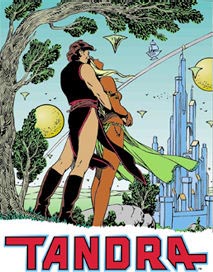 06-03-00
06-03-00 06-03-00
06-03-00
Tandra - The Best Comic Book You've Never Read
Naturally, I expect the above statement is something of an exaggeration. Obviously some of you have read Tandra, or the creator would never have been able to keep producing it as long as he has (over 20 years! How's that for a quiet self-publishing success?), but from the blank stares I get whenever I mention it to other readers and retailers, it is certainly not well known.
Which is, sadly, your loss.
Tandra is actually one long narrative, a true graphic novel, which was begun in 1973 by the creator Hanther. It began as the story of David Galon, an Earthman who is, apparently magically, transported to the world of Tandra in pursuit of a princess. What starts as out as an apparent fantasy, over the course of succeeding books, turns into an exploration of philosophy, morality, economics and politics, while never losing sight of the adventure comics medium in which it finds its roots. It is at times equally serious (and I don't mean the type of melodramatic posing that passes for seriousness in mainstream comics) and comical....witness the names of supporting characters Yousles, who is anything but, and Helifayeno (his introduction is a fun scene in itself). The story is engaging, not just on a visual level, but on an intellectual one as well. Scenes can go from swashbuckling swordfights to arguments over economic policy, while remaining consistently coherent and focussed. The object of the narrative eventually becomes David Galon's son, Dragonrok, and even that transition (as far as I have read to date) is smooth and story driven.
Visually, Tandra is a treat. Hanther's enjoyment of drawing the human form is evident in every figure he draws. The philosophy he expresses in the story is displayed in every line he commits to paper. His art is not pictures randomly thrown together, but every line has a purpose, and contributes towards the final goal. His work is crisp and clean; it aids the story as good art should, and while you can slow down your reading to appreciate the visual feast, you are never forced to do so by a deliberate obscurity of images. Although Hanther expresses his own flavor in his work, the inspiration he received from such notables as Al Williamson and Alex Raymond are evident and provide a slightly nostalgic tone to the art. Unlike many of his predecessors in this vein, Hanther does not shy away from constructing complete backgrounds. His architecture is a large part of the attractiveness of the art, and the vistas he creates demonstrate Tandra as more than just a setting; it is a world. (For the prurient, be warned: he also likes to draw naked ladies.....and he does them very well too.)
One of the most obvious influences on Hanther is the philosophy of Ayn Rand (who makes a sort of "guest appearance" in the story), and his story expresses some of these ideas in action, although his own ideas eventually go beyond Objectivist doctrine. This means that the story is ultimately positive in intent, and driven by a strong sense of ethics and morality. It also means that at no point is he trying to offer a ripoff story with pretty pictures to the reader. This is no imitation of anything done better; this is the real thing. Ayn wrote in "The Romantic Manifesto" that : "Art is a selective re-creation of reality according to an artist's metaphysical value-judgements", meaning, in brief, that what the artist expresses in his art is the world that he thinks does or ought to exist. In my opinion, Hanther's "Tandra" is a thoroughly well-constructed world, and I think it would be my highest compliment to him that it is a world in which I would want to live.
Hanther is still producing "Tandra", and you can see and order his work online at www.tandra.com. Go there. Now.